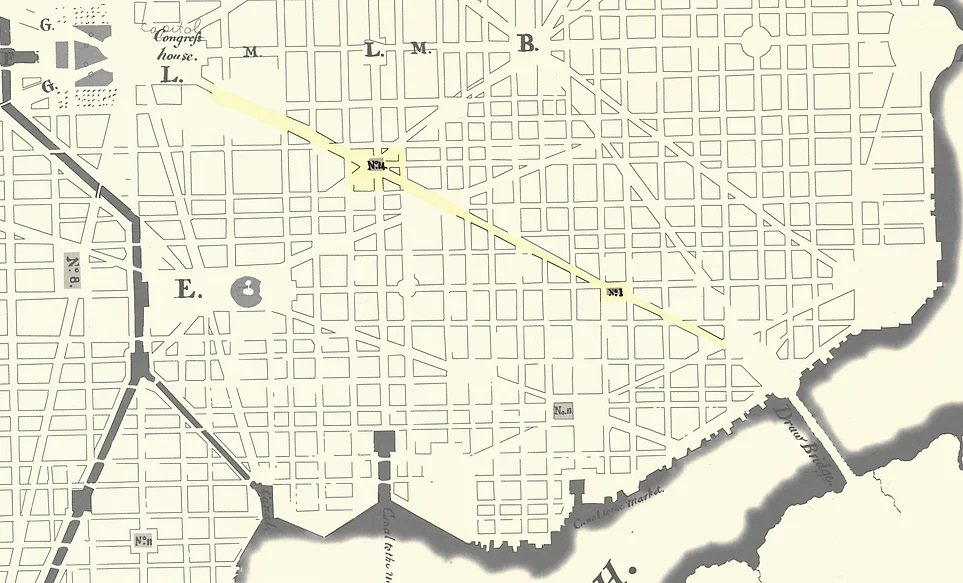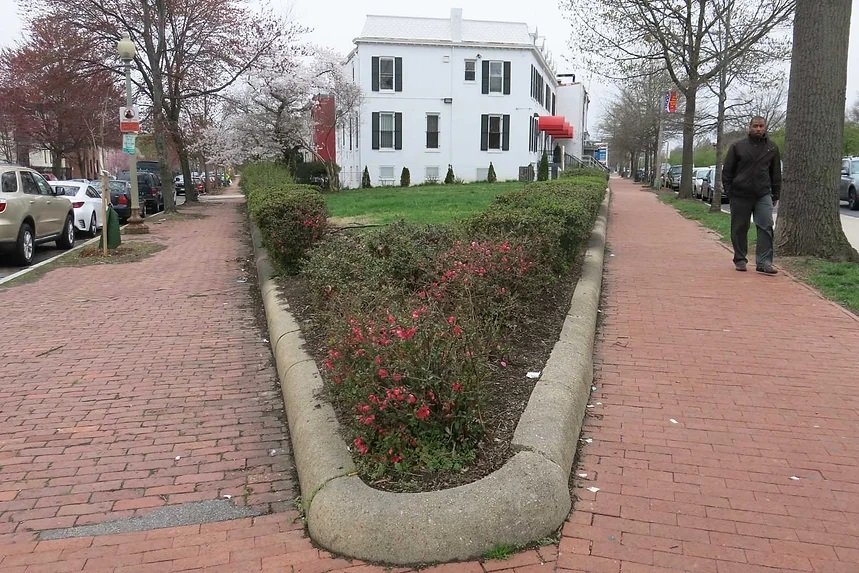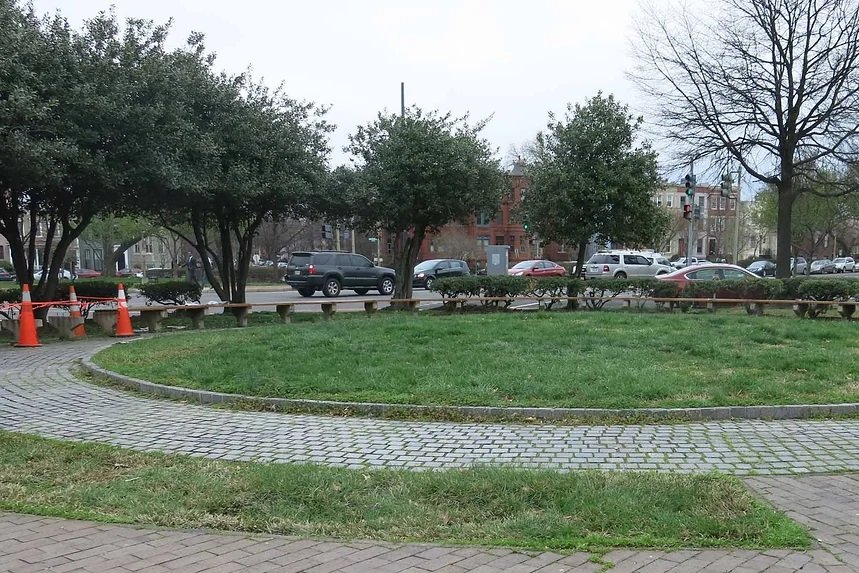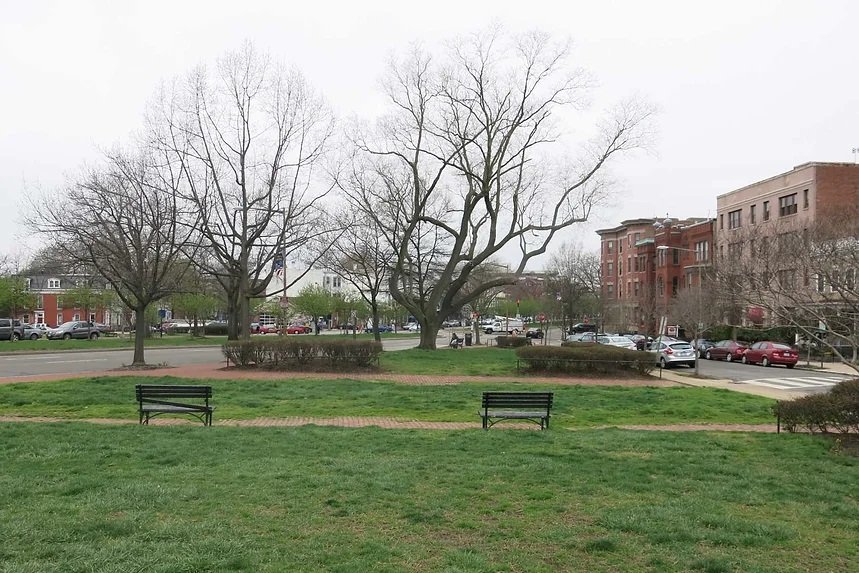Pennsylvania Avenue SE
Washington, DC | 2013 - 2014
Cultural Landscape Inventory
Project Team: Randall Mason, Shannon Garrison, Collette Kinane

History
Located in the heart of the historic Capitol Hill neighborhood, Pennsylvania Avenue SE Corridor, has served as a local commercial route since the mid-19th century. The avenue was first laid out as part of Pierre L’Enfant’s plan for the city of Washington, in 1791. Despite its proximity to the Capitol building, the surrounding neighborhood remained largely undeveloped until after the Civil War. Pennsylvania Avenue SE was unpaved until the 1870s, though the blocks immediately southeast of the Capitol building were graveled over in 1858. Installation of the city’s first streetcar line in 1862 drove increased commercial investment along the avenue, and citywide improvements to infrastructure led to the eventual paving of the avenue between Capitol Hill and 11th Street SE in the 1870s. Sewers were laid under the street at this time, streetlights installed and trees planted along sidewalks and traffic medians. The triangle parks surrounding the avenue were first delineated and improved with landscaping in the 1880s.
Streetcars ran through the center of Pennsylvania Avenue SE Corridor for 100 years before bus service officially replaced them in 1962. The streetcar line that ran down Pennsylvania Avenue SE Corridor was the first in Washington, DC. as well as the last in operation in the 1960s. Tracks were pulled up, sodded and planted over with turf grass, flowering trees and shrubs in 1965, as part of Phase I of Lady Bird Johnson’s Beautification Project. In the 1970s many of the squares along Pennsylvania Avenue SE Corridor were excavated during construction of the city’s Metrorail. Eastern Market and Potomac Avenue Metro Stations opened below Pennsylvania Avenue, SE Corridor in 1977. Reservations surrounding the Eastern Market Metro Station were transferred to Washington, DC. in the 1970s. In 2001, squares and parks along Pennsylvania Avenue, SE Corridor, were identified as potential sites of future memorials in the National Capital Planning Commission’s Comprehensive Plan for the National Capital.
Analysis + Evaluation
The Pennsylvania Avenue SE Corridor Cultural Landscape Inventory finds that Pennsylvania Avenue SE Corridor retains integrity from all three periods of significance: the L’Enfant Plan (1791-1792), the streetcar era (1862-1962) and the Lady Bird Beautification Project (1965-1968). Pennsylvania Avenue SE Corridor has retained many of its landscape characteristics and features and displays many of the seven aspects that determine integrity as defined by the National Register of Historic Places including: location, design, setting, feeling and association.
Contributing landscape characteristics identified for Pennsylvania Avenue SE Corridor are spatial organization, land use, circulation, small-scale features, vegetation, views and vistas and archeology.
Spatial Organization: The current spatial organization of Pennsylvania Avenue, SE Corridor is similar to that envisioned by Pierre Charles L’Enfant during the first period of significance. The primary organizing element from this period is the diagonal axis of the street. The diagonal has been maintained since it was first laid out by Andrew Ellicot and Benjamin Banneker circa 1792. Subsequent modifications to the street have maintained the original diagonal design, though streetcar tracks and modern paving, installed in the 1860s and 1870s, divided two of L’Enfant’s original squares into a series of smaller triangles. Neither L’Enfant nor Ellicott delineated the small triangle parks along Pennsylvania Avenue, though their creation is a result of L’Enfant’s design, and its combination of orthogonal streets with diagonal avenues. Their delineation during the second period of significance is in keeping with the original spatial organization, and the Pennsylvania Avenue SE Corridor landscape retains a high level of integrity to the first and second periods of significance.
Land Use: The Pennsylvania Avenue SE Corridor has a consistent history of land use, as a mode of transportation, since it was laid out circa 1792. During the first period of significance pedestrians, horsemen and horse drawn carts shared the entire width of the road. During the second period of significance, the city’s first streetcar line ran down the center of the avenue. Even after the streetcar tracks were sodded over, during the third period of significance, the new traffic medians served an important transportation function, by separating oncoming traffic on a busy downtown street. These Pennsylvania Avenue SE medians retain high integrity to their use during the first, second and third periods of significance. The triangle parks along the avenue were first developed and designed as small, green “breathing spaces” during the second period of significance and continue to serve that function. These reservations retain a high degree of integrity of use to the second period of significance.
Circulation: The key historic circulation feature of the Pennsylvania Avenue SE Corridor is the avenue itself. The street has been a functioning thoroughfare since the first period of significance. Small medians were first installed along the avenue during the second period of significance to separate the streetcar from other vehicles. Since the streetcar tracks were sodded over during the third period of significance, circulation along the medians is limited to social trails running between the trees and across the avenue—still the medians retain partial integrity of circulation to the second periods of significance, when medians were first installed, and high degree of integrity to the third period of significance. Squares and triangle parks along the avenues were not developed until the second period of significance, during which time pedestrian circulation was designed for some of these spaces. These circulation patterns were generally maintained during the beatification projects of the 1960s, though some were redesigned in the 1970s during the construction of the Metrorail. As a result, the triangle parks retain partial integrity to the second period of significance.
Vegetation: There is no record of the type of vegetation that existed along the Pennsylvania Avenue SE Corridor during the first period of significance. During the second period of significance rows of trees were planted along the narrow medians separating the streetcar from the street. Some of these trees were maintained when the medians were sodded and replanted with turf and double rows of magnolia trees, during the third period of significance. The original magnolias were replaced with flowering crabapples in the late 1990s, though the overall planting plan from the 1965 was retained, and turf grass continues to serve as the main ground cover for all medians. Many of the triangle parks still contain trees dating to the second period of significance. Thus, the Pennsylvania Avenue SE Corridor cultural landscape retains some integrity of vegetation to the second and third periods of significance.
Views and Vistas: Pennsylvania Avenue SE Corridor’s unobstructed view of the Capitol building, designed by L’Enfant, was partially obstructed by the Library of Congress building, completed in 1897. Despite the compromised nature of the main vista along the avenue, many of L’Enfant’s designed vistas along the orthogonal streets have been maintained. No significant views or vistas were designed during the other periods of significance and the avenue retains integrity to the original L’Enfant plan.
Small-Scale Features: Nearly all small scale features within the Pennsylvania Avenue SE Corridor post-date the periods of significance except for some curbing installed in the 1870s and early 1900s. The site retains a small degree of integrity of small scale features to the second period of significance.
Archeology: No significant archeological investigations have been conducted within the Pennsylvania Avenue SE Corridor though sections of the street and surrounding parks have been excavated, most recently in the 1970s, for the installation of the Metrorail. Archeological studies in the surrounding areas, including the excavation of Barney Circle and Virginia Avenue, have uncovered original cobblestone streets and artifacts dating to various period of inhabitation, including pre-Columbian. Past use indicates that the Pennsylvania Avenue SE Corridor may contain archeological material related to the history of transportation in Washington, DC. Archeological evidence of early Colonial and Native American settlements may also be present.
A detail of the L'Enfant Plan showing Pennsylvania Avenue SE corridor, which runs between the "Congress house" to the draw bridge crossing the Anacostia in the lower left corner. Also shown are squares No. 14 and No. 1, as originally designed by L'Enfant. (Pierre Charles L'Enfant, "Plan of the city intended for the permanent seat of the government of the United States...," 1791. Library of Congress Prints and Photographs Division)
Detail showing development along Pennsylvania Avenue SE corridor prior to the Civil War. Albert Boschke, "Topographical Map of the District of Columbia, Surveyed in the Years 1856 '57 '58 and '59," 1861 (Library of Congress Prints and Photographs Division)
Engineering map showing street paving along Pennsylvania Avenue SE corridor in 1880. (F.V. Greene, "City of Washington, statistical maps," 1880. Library of Congress Prints and Photographs Division)
Baist's 1913 Atlas (Plate 30) showing expanding development along eastern section of Pennsylvania Avenue SE corridor. (G. Wm., H.V. and Wm. E. Baist, "Baist's real estate atlas of surveys of Washington, District of Columbia, Vol. II, 1913. Library of Congress Prints and Photographs Division)
Photo from 1927 survey of all NPS reservations, showing center medians and streetcar between Third and Fourth Streets SE. (National Park Service Land Files)
Photo from 1927 survey of all NPS reservations showing triangle park at Fourth Street SE. (National Park Service Land Files)
Part of NPS planting design for Pennsylvania Avenue SE corridor, part of Lady Bird Johnson's Beautification Program. (National Park Service, "Planting Plan: PA Ave. 2nd St. SE to Barney Circle SE," NPS E-Tic)
HABS photo of Pennsylvania Avenue SE corridor showing 1960s wide medians with Beautification Program plantings. (HABS photos, Library of Congress Prints and Photographs Division)
HABS photo of Pennsylvania Avenue SE corridor showing 1960s wide medians with Beautification Program plantings. (HABS photos, Library of Congress Prints and Photographs Division)
A large expanse of green space at Seward Square, facing 5th Street SE. Benches provide a place for pedestrians to rest. (Photo by Shannon Garrison)
Quarter-round curbing at Reservation 052. (Photo by Shannon Garrison)
Holly trees at Seward Square. (Photo by Shannon Garrison)
Seward Square, north of Pennsylvania Avenue SE corridor, showing original cut of 5th Street SE, sodded over in 1963. (Photo by Shannon Garrison)
Vistas along Pennsylvania Avenue SE facing the Capitol building. (Photo by Shannon Garrison)
Crabapples at Pennsylvania Avenue SE corridor medians. (Photo by Molly Lester)














